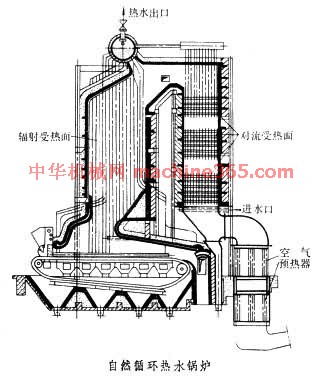1) boiler fuel oil heater


锅炉燃油加热器
2) the fuel oil hot water boiler


燃油热水锅炉
1.
At the hotel s request,the authors in this paper have proposed three hot water designs,namely the use of the air-source heat pump hot water unit,the use of the fuel oil hot water boiler and the use of the electric heating water boiler.
根据酒店方面的要求,提出三个热水设计方案,即采用空气源热泵热水机组、采用燃油热水锅炉和采用电热水锅炉,并进行运行成本的分析,做出设计方案的选择。
3) pot type oil (gas) burning hot water boiler


锅壳式燃油(气)热水锅炉
4) oil-burning boiler


燃油锅炉
1.
Application of fiber-bag precipitator on oil-burning boiler;


袋式除尘器在燃油锅炉上的应用
2.
Following the development of the cities, oil-burning boilers and spare generators to the buildings are being applied more and more.
燃油锅炉和建筑物自备发电机随着城市发展而越来越多地应用。
5) Oil-fired boiler


燃油锅炉
1.
The feasibility analysis of modification of oil-fired boiler to burn emulsified oil;


燃油锅炉改烧乳化油的可行性分析
2.
Application Analysis for Threaded Flue in Oil-fired Boiler;


燃油锅炉中螺纹烟管的应用分析
3.
Improvement and test on slurry feed system of coal water slurry fired boilersconverted from oil-fired boilers;
燃油锅炉改烧水煤浆供浆系统的改进及其试验
6) oil burning boiler


燃油锅炉
1.
Taking a swimming pool project as example,the author introduces the application of air source heat pump,And the comparison of economy between air source heat pump and oil burning boiler serving as thermal power is made.
以一游泳池工程为例,介绍了空气源热泵的应用,并对应用空气源热泵作为热动力和应用燃油锅炉作为热动力的经济性进行了对比。
2.
Described in this paper is a detailed introduction of the peak shaving operation of 400t/h oil burning boilers in Huangpu Power Plant,which are made by Shanghai Boiler Works Ltd.
论述了黄埔发电厂的 40 0t/h燃油锅炉的调峰运行 ,指出了调峰运行的要点、设备改造、优化运行以及调峰运行锅炉的前
3.
Through the practical application of 0il burning boilers in actual engineering, this paper carries out a synthetical comparison between oil burning boilers and coal burning boilers in the aspectsof technology, economy, enviromental protection and engineering cost.
本文通过燃油锅炉在实际工程中的具体运用,与燃煤锅炉进行了技术经济、环境保护、工程造价等方面的综合比较。
补充资料:动力机械: 热水锅炉
生产采暖和生产工艺用热水的锅炉﹐有时也可作为热电站的高峰供热锅炉﹐以调节热网负荷。热水锅炉内的水温低于饱和温度﹐与蒸汽锅炉相比﹐热水锅炉的烟气与水的温差较大﹐水垢少﹐传热情况较好﹐而且热水供热系统比蒸汽供热系统的热损失小得多﹐所以热水锅炉用于供热有较好的节能效果。中国将出水温度在 130℃以上的称为高温热水锅炉﹐低于 130℃的称为低温热水锅炉。
早期的小容量低温热水锅炉大多是铸铁对片组合式锅炉。这种锅炉本体由一片片的铸铁对片组合而成﹐可按产热量大小来配置对片数。铸铁对片组合式锅炉具有耐氧和酸腐蚀的特点﹐但产热量小﹐只用于供热量较小的场合。 大容量高温热水锅炉都是钢管式的﹐通常根据锅炉辐射受热面上介质流动方式分为自然循环式和直流式两种。 自然循环热水锅炉的结构与蒸汽锅炉相仿(见图 自然循环热水锅炉  )。进水一般先经对流受热面再经辐射受热面﹐最后由上锅筒顶部引出。在燃用含硫量较高的燃料和进水温度有波动时﹐为防止低温区受热面(省煤器)受烟气腐蚀和减少管内汽化产生水击﹐也可采用进水先经辐射受热面﹑后经对流受热面的方式﹐以提高低温区受热面的壁温。热水锅炉内不发生水的汽化﹐也无过热器﹐不存在汽水分离的问题﹐所以锅筒直径可以减小。
)。进水一般先经对流受热面再经辐射受热面﹐最后由上锅筒顶部引出。在燃用含硫量较高的燃料和进水温度有波动时﹐为防止低温区受热面(省煤器)受烟气腐蚀和减少管内汽化产生水击﹐也可采用进水先经辐射受热面﹑后经对流受热面的方式﹐以提高低温区受热面的壁温。热水锅炉内不发生水的汽化﹐也无过热器﹐不存在汽水分离的问题﹐所以锅筒直径可以减小。
直流式热水锅炉没有锅筒﹐钢材耗量较低﹐但在运行中遇到停电时可能因进水突然中断和管壁得不到充分冷却而造成设备事故。设计直流式热水锅炉时﹐要求管内的水有一定的流速和管间流量分配均匀﹐以避免水速低的管子中积聚气体和局部汽化。热水锅炉的出水温度一般至少应比工作压力下的饱和温度低20℃﹐以保证锅炉内不发生汽化。
说明:补充资料仅用于学习参考,请勿用于其它任何用途。
参考词条